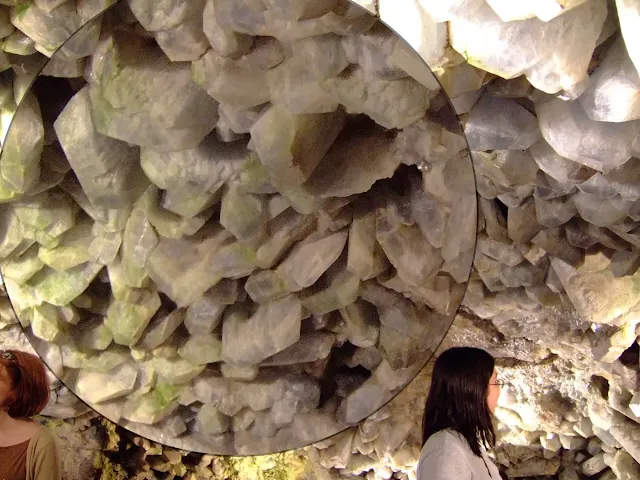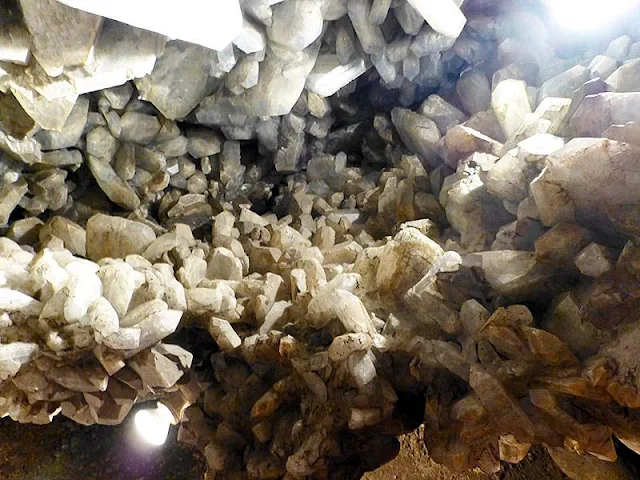The Crystal Cave in Ohio: Formation, Visiting, Photos
The Crystal Cave in Put-in-Bay, Ohio, is home to the world's largest geode, containing stunning celestine crystals that can grow up to 3 feet wide! These bluish-white crystals line the walls of the cave, creating a truly magical and otherworldly atmosphere.
It is also home to some of the largest celestite crystals in the world, with some measuring up to 3 feet (1 meter) in width. The walls are blanketed in these bluish-white beauties, ranging from 8 to 18 inches long. The cave was discovered in 1897 by Gustav Heineman, who was digging a well on his property.
The Crystal Cave is a limestone cave located in Put-in-Bay, Ohio, located on South Bass Island in Lake Erie. The Crystal Cave, 40 feet under ground, was discovered while workers were digging a well for the winery back in 1897.
In 1897 he sank a well beneath his winery and discovered a large vug in 10 m depth. On exploring the cave he found, that much of the cave walls showed extremely large and well developed tabular crystals, which turned out to be strontium sulfate, i.e. almost pure celestite.
 |
| The Crystal Cave, the worlds largest geode. Located under Heinemans Winery, Put-In-Bay, Ohio Photo: Analogue Kid |
The original cave was much smaller than what is shown today, as much of the celestite crystals were mined for the manufacturing of fire-works. However, Mr. Heineman decided very early to stop the mining activities and turned the property into a tourist attraction called "Crystal Cave".
The crystals range from 8 to a massive three feet long... and as hard as it is to believe, there used to be way more of them. Over time, crystals were harvested and sold off to make fireworks; on the bright side, less crystals means more room for visitors to move around inside.
The Crystal Cave in Ohio Formation
To understand its formation, we delve into the region's geological history.
Paleozoic Era: Shallow seas deposited carbonate-rich sediments (dolomite and limestone) during the Silurian Period.
Late Paleozoic and Early Mesozoic Eras: Tectonic activity uplifted the region, exposing sediments to weathering and erosion. Subsequent diagenetic processes cemented and recrystallized the carbonate rocks.
Tertiary Period: Continued tectonic activity tilted the strata, leading to differential erosion that exposed underlying formations.
Quaternary Period: Glacial events and fluctuating water tables triggered karstic processes in the carbonate bedrock. Acidic groundwater preferentially dissolved limestone, creating vugs (voids) within the less soluble dolomite.
Mineralization and Crystal Growth: Groundwater rich in strontium sulfate (SrSO₄) circulated through the vugs. Specific conditions (stable temperature, pressure, trace elements) facilitated the precipitation of SrSO₄ as celestine (SrSO₄). Over millions of years, celestine crystals nucleated and grew to their present size and diverse morphology.
 |
| Interior of the Crystal cave at Put-in-Bay, Ohio. Photo : John Rees |
Visit The Crystal Cave in Ohio
Today, the Crystal Cave is open for tours from early May until late September. Tours are $12 for adults and $7 for children ages 6 to 11. Children under 6 are free. Tours last about 30 minutes and include a walk through the cave, as well as information about its history and geology.
The Crystal Cave today is open to the public on a daily basis. Where celestine crystals of up to 3 feet (1 m) in width can be viewed. The crystals form extensive linings on the limestone walls of the 30 foot (10 m) deep cave.
Coordinates : 41°39'N , 82°84'W : Crystal Cave, Put-in-Bay, South Bass Island, Ottawa Co., Ohio, USA







%20(1).webp)





